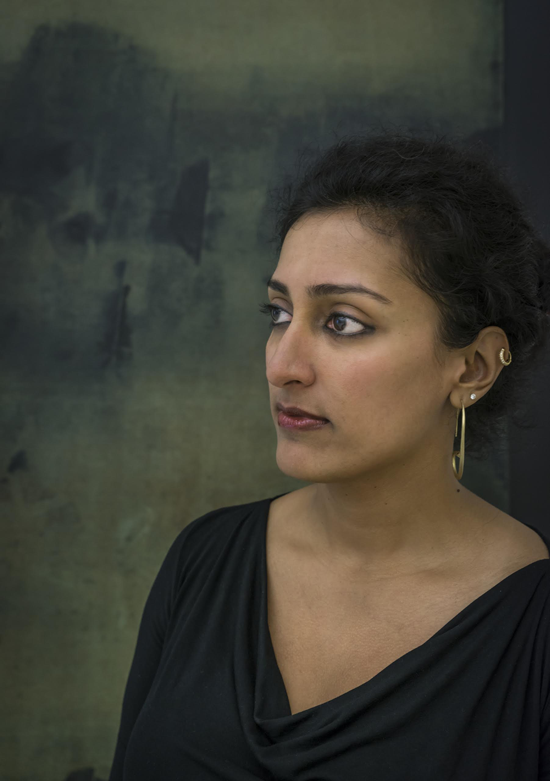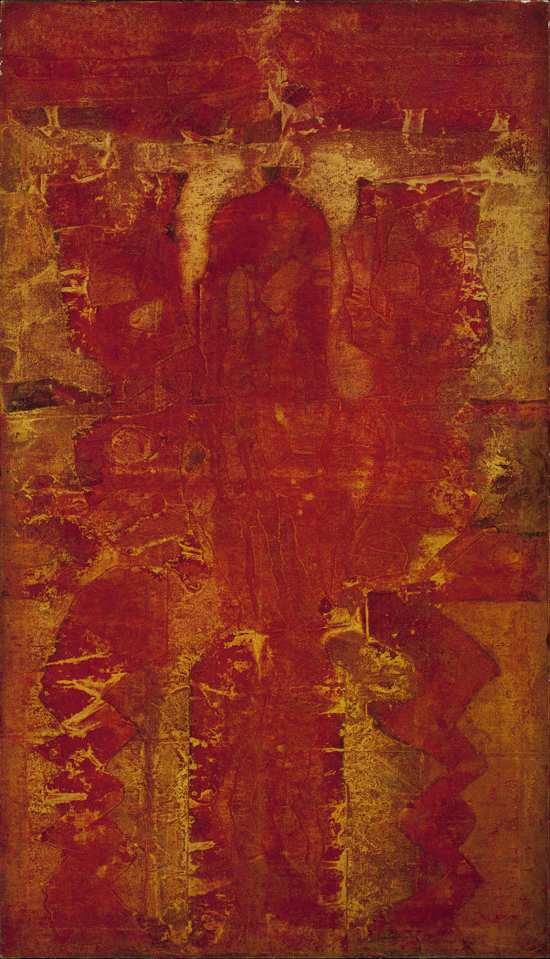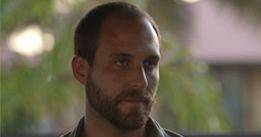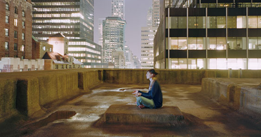
Trying to identify an artist’s Zen Buddhist influence is something of a fool’s errand—and perhaps an antithetical one. The religion, after all, has a long, proud tradition of underplaying any overt impact it has on an adherent’s life. Ancient master Hiakajo Roshi famously summed up the practice with a rather spare injunction for students to eat when hungry and sleep when tired. Chan master Linji Yixuan, founder of the Rinzai school, echoes the sentiment in his oft-cited koan “If you meet the Buddha on the road, kill him.” Nevertheless, Zen Buddhist artists abound, so it’s tempting to wonder how practice might mingle with craft.
After coming of age and attending art school amid India’s independence movement, Gaitonde discovered Buddhism while working as a painter in Mumbai during the 1950s. The Guggenheim New York’s retrospective exhibit, V.S. Gaitonde: Painting as Process, Painting as Life, opened in late October and runs until February 11th. Tricycle spoke with the exhibit’s curator, Sandhini Poddar, herself a practicing Buddhist, about what first interested her in Gaitonde’s work, how Gaitonde conceived of the overlap between Zen and painting, and the significance of the Guggenheim’s effort to expand its collection beyond Western artists.
Describe the first time you saw Gaitonde’s work. For generations my family has been involved in the arts, so I first came across Gaitonde’s work when I was only 4 or 5 years old. Living in Mumbai, we all grew up knowing his name. More recently, in 1998, I saw a series of his works and they really struck me; they stayed with me for a very long time. His work had this amazing abstraction that he was able to convey through light, space, and color. You don’t see that with any other artist from India. There was this simultaneous stillness and imminence in the work. And, of course, I found the colors beautiful. I had a thought in the back of my mind saying, “This work really speaks to and inspires me. I wonder if I can ever do something with it.”
You mentioned that you were struck by the simultaneous stillness and imminence of his work. The description of the exhibit on the Guggenheim’s website implies that there was a connection between Gaitonde’s interest in Zen Buddhism and the development of those features of his work. What do we know about his Buddhist practice and how it influenced his art? We know that he came upon Zen Buddhism while living and working in Mumbai in the late 1950s. He found publications related to Zen Buddhism and it was, for him, foremost an intellectual system that helped guide and inform his life. He continued to speak about Zen all the way up to the 1990s, giving interviews that I found on file at the Museum of Modern Art.
What does he say about Zen in those interviews? Initially, in the 1960s, he talked about how Zen was an important philosophical system that guided him, specifically with regard to his interest in nature. It also helped him cultivate immediacy, spontaneity, concentration, and attention in his work. The influence had to do with creativity deriving from his isolation as an artist—a certain silencing of the mind.
That ethos lends itself to nonrepresentational, abstract art. Do you feel that his interest in Zen pushed him in that direction? I think it accompanied his movement in that direction. It’s really hard to pick out a single impulse or influence, because I don’t think artists work that way. They’re much more osmotic and sponge-like in the way that they pick up ideas and influences from diverse sources.
But Zen certainly is one of the key influences for Gaitonde because it’s one of those threads that binds his practice overall—from 1958, when he turned toward the nonobjective, right until the late 90s when he stopped making art. For the first decade after he attended art school in the 1940s, he was trying different things out. He was veering toward abstraction, but he was still quite committed to the traditions of the figure and of the body, which he inherited from his academic training. For some, philosophy allows their view to be less bogged down by the visual world. For these types of people, art isn’t just about watching cinema or going to the theatre or seeing friends or paying attention to received histories; philosophy enables them to live more abstractly.
You describe a coexistence in his early work of abstraction on the one hand and on the other a commitment to traditional images like the figure of the body. This corresponds with Zen’s paradoxical emphasis on both freedom and structure, spontaneity along with rigorous attention to posture. I think that that is where Zen moves through the body and through the mind into the work. The art is not about depicting Zen. It’s not a representation of a philosophy; it’s rather about internalizing Zen and imbibing it in terms of one’s life decisions, and those life decisions then enable one to make work in a certain way.

You participated in a ten-day meditation retreat back in 2008. Talk about your own interest in Buddhism. On a personal level, Vipassana brought about a very important breaking point in my life—not in a negative sense, in an extremely affirmative sense.
What do you mean by that? It reveals you to you. That’s what I mean by a breaking open. You break yourself open to yourself. And it’s extremely frightening, which is why even though I had wanted to go on retreat since I was a teenager, it took a while for me to actually summon up the courage to go. But after the ten days I realized the experience had had this permanent effect on me: the self-awareness I was able to gain provided this incredible sense of self-reliance. Now even in the most difficult situations I have that meditative space within me.
No matter what your emotions throw up and what the mind throws up you have to realize that this is all very transient. There’s no reason to get attached. Being the observer in that chain of cause and effect is an extremely empowering position. I’ve been able to apply it in my day-to-day life in all kinds of situations—that’s what I mean by the embodiment of a principle or philosophical attitude.
This exhibit is part of the Guggenheim’s effort to expand its collection beyond artists from the United States and Europe, which includes its plan to open a satellite museum in Abu Dhabi. It’s a good sign that a major cultural institution in the West is looking outside its predominantly white, male collection, though non-Western artists then receive a platform from what remains a very Western institution. What do you make of that tension? It’s a valid tension because the reason that I’m invested in what’s happening—not just in New York but in Abu Dhabi—is because it’s coming from a new set of politics. If we had a museum originating in India I would want to be very involved with that as well, because we are in the 21st century and need to be global citizens. I think that institutions in the West have been a bit lazy and condescending about only allying themselves with America or Europe through the 20th century.
Having said that, I really do believe in local art histories, languages, and cultural specificities. We’re trying as much as we can to make sure that the future museum in Abu Dhabi is global in that it’s looking at art produced anywhere in the world, but also speaks to an audience apart from those who travel from abroad. We need to make sure that regions like the Middle East, the Gulf, North Africa, and South Asia are well represented not just through the acquisitions but also in exhibitions, public programs, and workshops. I don’t think that this can be accomplished by 2017—it’s a multigenerational project. These attempts to place art, ideas, and communities on an equal footing are very important in light of the social, political, and economic imbalances of the 20th century. The recent past has been so fraught politically that we need culture to provide something aspirational. Culture can be so generative and powerful because it doesn’t follow the same rules. It’s a place of liberation and creativity.
—Max Zahn, Editorial Assistant
More at Tricycle:
|
BLOG: I SURVIVED EBOLA. BUT THE FIGHT DOESN’T END THERE. |
BLOG: FOSTERING PEACE, INSIDE AND OUT |

